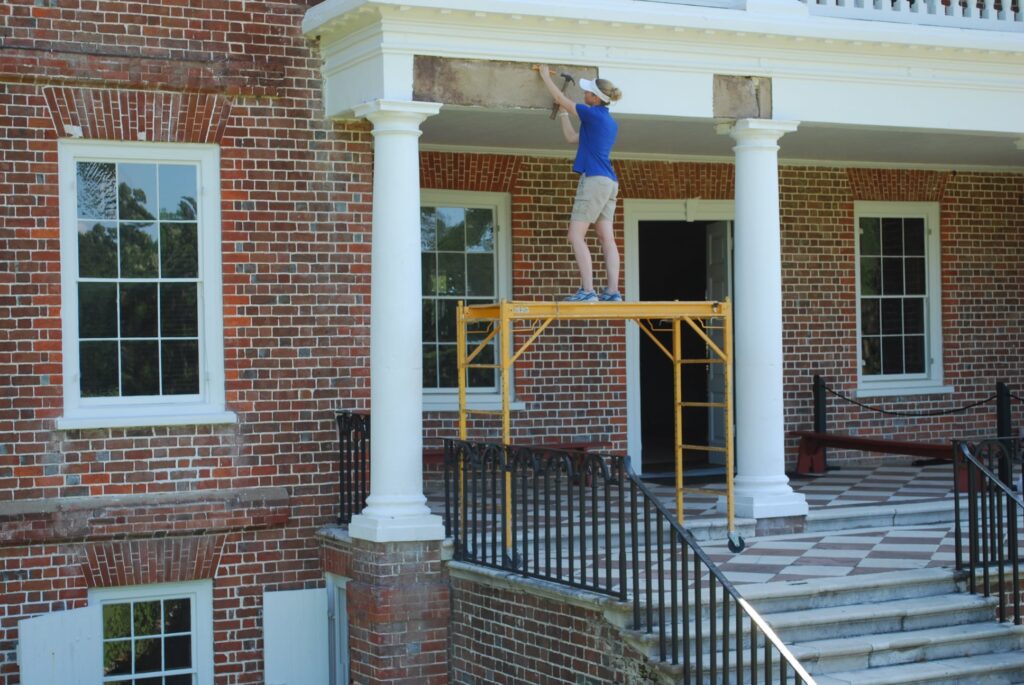Richard “Moby” Marks, preservation contractor (shown above). For decades, he has worked on the preservation and repair of Drayton Hall. Imagining the house as a “time machine,” he explains why Drayton Hall was, and is still, unique and enables us to see, as only a contractor can, the processes involved in constructing Drayton Hall and the handwork of its builders, including the enslaved. Because of all that it offers, he envisions Drayton Hall as a center for preservation learning.
GWM: What have you learned that visitors may not see?
RMM: Most visitors miss how the finer points of the brick masonry show how Drayton Hall is a high style, Georgian edifice. The regularity of the brick work, the fine butter joints at each end of a brick, the tight lines of mortar between bricks, and the shaped and rubbed bricks in the jack arches of the windows and around the doors, all represent the highest form of construction in that era.
The fine alignment of the Flemish bond brickwork is unparalleled. A mason today would have a hard time replicating all the techniques seen here. What about getting the clay, winnowing it, putting it in molds to shape it into bricks, and then firing it? Records of who did all this work have not been found, but an advantage for visitors is that much of this work was done in an area about a half a mile radius around this building, so perhaps they could imagine the work sites.
Could they imagine what a feat it was to take all of those raw materials and transform them by hand into what we see today as this grand building?
Above: Flemish bond masonry of Drayton Hall. Details count:
1) The door opening is accented by rubbed brick to produce a light color.
2) “Queen closers”, or a half brick, are used for alignment.
3) The differences in color made the colors less uniform, and along with the slight differences in sizes and shapes, demonstrate that the bricks were handmade.
4) The alternating orientation of the bricks by the door opening and at the wall’s end create a rhythm that eye picks up on.
5. The horizontal and vertical lines of mortar are straight, but not perfectly straight, and indicate that unlike us humans, the house has not sagged significantly over time.

Above: Preservation of the portico offers a close view of the brickwork. While brickwork may offer a uniform appearance, the eye picks up variations:
1) Window and door openings are accented by rubbed brick of a lighter color.
2) Bricks in the jack arches above the windows and door taper in width as the bricks descend, but the mortar joint remains a thin, straight line of the same width.
3. Bricks in jack arches alternate in orientation.
4) Belt courses project slightly, breaking the monotony and indicating floor divisions.
5) Records have not been found that identify the architect, contractors, craftspeople, or workers who built Drayton Hall. In all likelihood, it was constructed by people both free and enslaved and from England and the British Isles, the American colonies, especially Charleston, and Africa.
6) It is suspected that John Drayton, the owner, had a strong hand in its design and construction.
 George W. McDaniel, Ph.D., is President of McDaniel Consulting, LLC, a strategy firm that helps organizations use history to build bridges within itself and to its broader constituents. The company’s tag line, “Building Bridges through History,” is grounded in McDaniel’s personal beliefs and his experience in site management, preservation, education, board development, fundraising, and community outreach. Rather than using history to divide us, he strives to help organizations use history, especially local history, to enhance cross-cultural understanding and to support local museums, preservation, and education. Dr. McDaniel led volunteer efforts with Emanuel AME Church and historical organizations in Charleston to use historic preservation to enhance racial reconciliation and healing. McDaniel is also the Executive Director Emeritus of Drayton Hall, a historic site in Charleston, SC, owned by the National Trust for Historic Preservation. He retired from Drayton Hall in 2015 after 25 years of distinguished service.
George W. McDaniel, Ph.D., is President of McDaniel Consulting, LLC, a strategy firm that helps organizations use history to build bridges within itself and to its broader constituents. The company’s tag line, “Building Bridges through History,” is grounded in McDaniel’s personal beliefs and his experience in site management, preservation, education, board development, fundraising, and community outreach. Rather than using history to divide us, he strives to help organizations use history, especially local history, to enhance cross-cultural understanding and to support local museums, preservation, and education. Dr. McDaniel led volunteer efforts with Emanuel AME Church and historical organizations in Charleston to use historic preservation to enhance racial reconciliation and healing. McDaniel is also the Executive Director Emeritus of Drayton Hall, a historic site in Charleston, SC, owned by the National Trust for Historic Preservation. He retired from Drayton Hall in 2015 after 25 years of distinguished service.
A frequent writer, speaker, and facilitator about such issues, he can be reached at gmcdaniel4444@gmail.com or through his website at www.mcdanielconsulting.net.
All images courtesy of the author unless otherwise noted.

 McDaniel Consulting LLC is a strategy firm that helps organizations use history to build bridges within itself and its broader constituents.
McDaniel Consulting LLC is a strategy firm that helps organizations use history to build bridges within itself and its broader constituents.